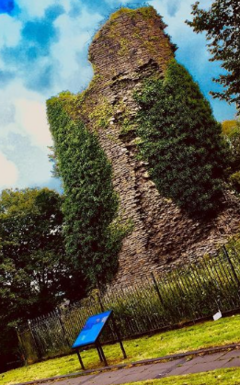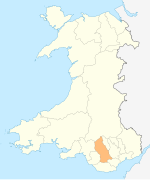Llantrisant
| Llantrisant | |
|---|---|
 Llantrisant Castle ruins | |
Location within Rhondda Cynon Taf | |
| Population | 15,313 (2011)[1] |
| OS grid reference | ST045835 |
| Community |
|
| Principal area | |
| Preserved county | |
| Country | Wales |
| Sovereign state | United Kingdom |
| Post town | PONTYPRIDD |
| Postcode district | CF38 |
| Post town | PONTYCLUN |
| Postcode district | CF72 |
| Dialling code | 01443 |
| Police | South Wales |
| Fire | South Wales |
| Ambulance | Welsh |
Pontypridd | |
Llantrisant (Welsh pronunciation:
History
There is evidence for settlements in and around Llantrisant stretching back over three millennia. Two Bronze Age burial mounds are on Mynydd Garthmaelwg, the opposite side of the Ely Valley.[3][4] A 1.05 metres (3 ft 5 in) tall, by 1.68 metres (5 ft 6 in) wide, possibly Bronze Age, standing stone, was discovered in Miskin during excavations prior to the M4 motorway construction.[5] An Iron Age hillfort stands on Rhiwsaeson Hill. The enclosure, now known as Caerau Hillfort, measures 230 metres (750 ft) by 180 metres (590 ft).[6]
A settlement has existed on this site from at least the beginning of the 6th century, when the poet Aneurin wrote of 'the white houses of Glamorgan' when referring to Llantrisant.[7] It was seized around 1246 by
In 1346, Llantrisant was granted a
Llantrisant was one of the eight boroughs constituting the Glamorgan borough following the
Culture
An ancient tradition called the
At nearby Tarren Deusant is a
Old Town Llantrisant has four pubs: The New Inn, the Bear, the Wheatsheaf and the Cross Keys Hotel. Formerly in the Bull Ring was the Rock and Fountain pub, which became the home of the original Llantrisant Workingmen's Club founded in May 1953 by Seth Morgan, Freeman of Llantrisant.
Notable buildings
The focal point of the town is the Bull Ring, a commercial square in the centre of the town that was used for bull-baiting, until it was disallowed in 1827 due to unruly crowds.[11] The square contains a statue of Dr William Price a pioneer of cremation.[8]
Model House
The first workhouse in Glamorgan opened in Llantrisant in May 1784, using a number of adapted cottages on Swan Street and part of the Black Cock pub on Yr Allt,[7] a road to the south west of the Bull Ring, between the parish church (to the west) and the castle (to the east).
The Union Workhouse was built in 1884 on the Bull Ring – west of where Dr Price's statue stands today and behind the
The building closed as a workhouse in the early 1900s and first became a boarding house, then an inn and later a general store, called County Stores. They were known as a cornflour and provisions merchant, and a linen and woolen drapers, also selling boots and shoes. The site was bought in the 1950s by 'Planet Gloves', who manufactured gloves there until the late 1960s. The Model House stood empty for many years before being bought by the local authority to convert into a craft and design centre.[12]
In 1989 the Model House re-opened as a craft and design centre. A registered charity, Model House was funded by the Arts Council of Wales[13] since the demise of the Arts Council of Great Britain in 1994, receiving about 35,000 visitors a year.[14] The ground floor contains galleries that include glass, ceramics and designer jewellery from established British and Welsh artists, as well as a local painter. The upper floors have workshops that are used by individual craftspeople, whose work can be purchased either from their studio or from the ground floor shop.[15] The Model House has a programme of art and crafts exhibitions throughout the year and hosts a varied series of workshops, where adults and children may learn the basics of a wide range of contemporary craft skills.[16]
The centre closed in December 2009 after the company which ran it, Model House Ltd, went into liquidation. The management of the building was taken over by Rhondda Cynon Taf County Borough Council, who after tackling structural problems with the roof and outer walls reopened the centre in mid 2010.[17]
Llantrisant Castle

Llantrisant Castle stands in parkland in the centre of the town though only one wall of the raven tower remains. Although initially built as a wooden fortification it was rebuilt as a stone structure around 1246 by Richard de Clare, Lord of Glamorgan. In 1294 the castle was damaged during the uprising against the Norman overlords, led by Madog ap Llywelyn, and again in 1316 by Llywelyn Bren. It is believed that the castle was destroyed in 1404 by Owain Glyndŵr though there is no written proof of the event. John Leland reported the castle as ruined in his writings in 1536.[18]
Llantrisant Guildhall

Llantrisant Guildhall, which was the meeting place of the borough council, was completed in 1773.[19]
Llantrisant Parish Church and Penuel Chapel

By the early 1900s Llantrisant had eight chapels, as well as the
The second religious building in Llantrisant is Tabor Baptist Chapel, built in 1828. It is in on an elevated site next to Llantrisant Castle, accessed by steps from the High Street.
Y Billy Wynt
At the highest point of Y Graig[21] is a stone tower known locally as “Billy Wynt”. Also said to have been used as an auxiliary tower with its high up positioning it remains a focal point of history. By the early 19th century the tower was in ruins and in 1890[22] it was restored as a folly by the Llantrisants' town trust.
Y Pwysty
‘Y Pwysty’ the weighing house, was located on this site since medieval times. Once known as The Angel Inn, it was at Y Pwysty that the weight of goods were regulated at the markets and fairs held in the town.[23]
The Royal Mint
The Royal Mint, which produces all British coins, moved from London to Llantrisant in 1967 in order to meet demand when the UK converted to decimal currency. In addition to British coins, the Royal Mint produces circulating coins for approximately 60 countries, as well as medals, bullion coins and bars.[24] The Royal Mint also attracts tourists to Llantrisant to The Royal Mint Experience and the Royal Mint Museum which runs events and exhibitions around topics of interest.[25]
Environment
Llantrisant is typical of most locations in the South Wales region, being home to typical upland habitat birds and mammals of the British Isles. The town also contains Llantrisant Common and Pastures, a 113-hectare (280-acre) Site of Special Scientific Interest, which is home to several rare plants.
Transport
Llantrisant is served by Pontyclun railway station three miles away, which was formerly known as Llantrisant railway station.[26] Trains run by Transport for Wales call at the station.
Employment and economy
The town is the home of the Royal Mint, which manufactures all British coins. The Royal Mint transferred to Llantrisant in 1967[8] and its attractions include the Mint's museum. The Mint employs around 900 people.[27] A number of small, independent retailers have successfully found a home in Llantrisant Old Town. In addition to the Model House Craft & Design Centre, now well-established in a former 18th-century workhouse in the town centre, there is a village shop known as the Bullring Stores, a traditional toy shop with added vintage finds, galleries, pubs and restaurants.
The history of education in Llantrisant is firmly based in the varied religious institutions and Sunday School services which rapidly flourished between the 17th and 19th centuries. The Norman parish church was the starting point for the education movement, although it was one that would take a century or more to fully develop into a successful entity.
Sport and leisure
Sport flourished in Llantrisant for centuries and the remains of a
Llantrisant Male Choir
The town is home to one of the very longest established male choirs in Wales. Established at least as early as 1898, the choir is a prolific touring choir having sung in the USA, Italy, Cyprus, Slovakia, Poland, France, Germany, Ireland, the Netherlands and Spain. They travel extensively in the UK supporting charity events and singing at concert engagements. The choir has appeared at many notable venues, including The Royal Albert Hall, The Santa Maria Maggiore, Wales Millennium Centre and the Hollywood Bowl. The choir has a wide-ranging membership drawn from all ages and social backgrounds. They sing a mix of music from traditional choral classics, Welsh hymns and modern pop music.
Notable people
- Sir Leoline Jenkins, politician and judge
- William Pricelived in the town.
- Andrew Bishop, Bradley Davies and Scott Andrews, Wales' international rugby union players.
Freemen of Llantrisant
- Sir David Evans: Lord Mayor of London in 1891
- Sir Cennydd George Traherne: Late Lord Lieutenant of Glamorgan 17 May 1935.[28]
- Trevor Rees
- Sir Brandon Meredith Rhys Williams: Late Conservative Politician
Twin towns
Llantrisant has a
 Crécy-en-Ponthieu, France, since 2015.[29]
Crécy-en-Ponthieu, France, since 2015.[29]
References
- ^ "Town population 2011". Retrieved 16 November 2015.
- ^ "Llantrisant Community Council Website". Llantrisant Community Council. Retrieved 1 October 2021.
- ^ "East round barrow, the beacons, Mynydd Garthmaelwg (93072)". Coflein. RCAHMW. Retrieved 22 October 2021.
- ^ "west round barrow, the beacons, Mynydd Garthmaelwg (93176)". Coflein. RCAHMW. Retrieved 12 January 2014.
- ^ "Miskin Menhir, not in situ (225899)". Coflein. RCAHMW. Retrieved 12 January 2014.
- ^ "Caerau Hillfort, Rhiwsaeson, Llantrisant (93037)". Coflein. RCAHMW. Retrieved 19 January 2016.
- ^ a b "Llantrisant timeline". Llantrisant Town Trust. Llantrisant freemen website. 2006. Archived from the original on 5 September 2012. Retrieved 30 August 2008.
- ^ ISBN 978-0-7083-1953-6
- ^ "Boys 'bounced' in bizarre tradition". BBC News. 7 June 2003. Retrieved 28 December 2012.
- ^ "Beating the Bounds in Llantrisant to celebrate charter". BBC. 8 June 2010. Retrieved 28 October 2008.
- ^ a b c "Llantrisant timeline". Llantrisant Town Trust. Llantrisant freemen website. 2006. Archived from the original on 7 September 2008. Retrieved 30 August 2008.
- ^ "Destination RCT - The Model House". RCTCBC. Rhondda Cynon Taf CBC. 2008. Archived from the original on 25 July 2008. Retrieved 30 August 2008.
- ^ "The Arts Council of Wales 2006/07 Budget". The Arts Council of Wales. The Arts Council of Wales. 1 March 2006. Archived from the original on 27 September 2006. Retrieved 30 August 2008.
- ^ "Exhibitions at the Model House Llantrisant". Vale Life. Vale Life. 2007–2008. Archived from the original on 13 May 2008. Retrieved 30 August 2008.
- ^ "Model House". The Model House. 2008. Retrieved 30 August 2008.
- ^ "Model House exhibitions". The Model House. The Model House. 2008. Retrieved 30 August 2008.
- ^ "Model House In Llantrisant To Reopen". BBC. 23 February 2010. Retrieved 23 February 2010.
- ^ "Llantrisant Timeline". Archived from the original on 5 September 2012.
- National Historic Assets of Wales. Retrieved 6 September 2023.
- ^ "Parish of Llantrisant". www.parishofllantrisant.org.uk.
- ^ "Billy Wynt". www.llantrisant.net.
- ^ "Read More - Page 2". www.llantrisant.net.
- ^ "Y Pwysty; The Angel Inn, Llantrisant (19788)". Coflein. RCAHMW.
- ^ "Timeline". The Royal Mint Museum. Retrieved 15 February 2017.
- ^ "About the Royal Mint". The Royal Mint. Retrieved 15 February 2017.
- ^ Peter Hamnet (November 2011). Llantrisant Conservation Area Appraisal and Management Plan (PDF) (Report). Rhondda Cynon Taf County Borough Council. p. 15. Archived from the original (PDF) on 24 September 2015. Retrieved 27 October 2014.
- ^ "About the Royal Mint". Royal Mint. Retrieved 24 February 2012.
- ^ "Traherne Dynasty".
- ^ "Battlefield Enemies Twinned In Friendship". Llantrisant Town Trust. Retrieved 20 June 2017.
- Sharp, Mick (1997). Holy Places of Celtic Britain. Blandford. ISBN 1-85079-315-8. Pps. 32–33.
- Powell, Dean; "Llantrisant" (Tempus Publishing Ltd 2001); "Llantrisant Revisited" (Tempus Publishing Ltd) 2002


